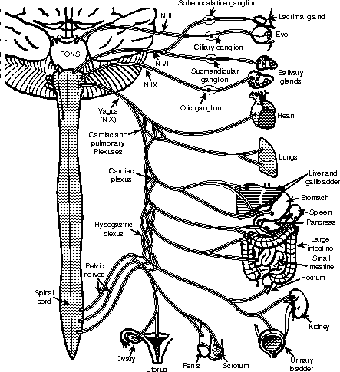Anatomy and Physiology: Parasympathetic: Aaaaaaaaaaah!
Parasympathetic: Aaaaaaaaaaah!
Okay, okay! Calm down! No, literally. How do you calm down? Here comes that danged homeostasis thing again. To stay on an even keel, you need an opposite response to the fight or flight response, which is called “rest and repose.”
Winding Organs Down
In addition to being used to gradually bring the body back from the fight or flight response, this branch of the ANS is more characteristic of a typical body response under normal circumstances. This may not be true of all species, or even all members within a species. Prey would most likely be using the sympathetic branch more often than predators. In addition, in social animals, those with a lower social standing in a dominance hierarchy (as in baboons) would also most likely be more sympathetic than parasympathetic. This is not to say that such animals are “wired differently,” but that they are forced to live under more stressful situations, more of the time.
In any case, simply think about all of the sympathetic responses and, well, reverse them! Slow down the heart, and the breathing. There is no need to be on the alert, so all those organ systems that were set aside, such as the digestive system, can now get back to work. Despite all of this, there are actually a number of organs where there is no parasympathetic stimulation. Think about the adrenal glands; epinephrine (E) and norepinephrine (NE) are released due to sympathetic stimulation. Have you ever noticed that, once the scare is over, it takes a while for you to feel normal? There is no parasympathetic stimulation, because the adrenal glands only release the E and NE under stress, thus there is no point to sending such a message. The following table lists sympathetic and parasympathetic changes, divided according to organ.
| Sympathetic and Parasympathetic Changes | ||
|---|---|---|
| Organs | Sympathetic Changes | Parasympathetic Changes |
| Adrenal gland | Epinephrine and norepinephrine | None (no innervation) |
| Digestive | Reduced activity | Increased activity |
| Secretion | Reduced secretions | Increased secretions |
| Liver | Hydrolysis of glycogen | Glycogen produced |
| Eye | Pupil dilation | Pupil constriction |
| Fat tissue | Fats broken down | None |
| Heart | Faster heart rate | Slower heart rate |
| Veins | Vasoconstriction | None |
| Arteries | Varies by organ | None |
| Kidneys | Less urine produced | More urine produced |
| Lacrimal glands | None (no innervation) | |
| Lungs | Bronchiole dilation | Bronchiole constriction |
| Muscles | Stronger contraction | None (no innervation) |
| Skin | Sweat, erect hairs | None (no innervation) |
Parasympathetic Pathways
When you compare the sympathetic and parasympathetic pathways, it's as if the spinal nerves were thinking, “I've got too much to do; I just can't be bothered to slow the body down!” Seriously, the vast majority of the spinal nerves are completely irrelevant! The tenth cranial nerve (N X), also called the vagus nerve, leaves either side of the medulla oblongata and just goes straight down the body on either side of the spine (see Figure 20.11).
To be fair, other nerves are involved, such as N III (oculomotor), N VII (facial), and N IX (glossopharyngeal). Each nerve has a specific ganglion involved. As for the vagus nerve, there are a number of plexuses involved: the cardiac and pulmonary plexus (to and from the heart and lungs), the celiac plexus (to and from the liver, stomach, and pancreas), and the hypogastric plexus (to and from the small and large intestines, and all of the pelvic organs). Three of the sacral nerves (S2 through S4) also help out by joining the hypogastric plexus.

Figure 20.11Note how the majority of the organs are innervated by branches of the tenth cranial nerve, the vagus nerve (N X).

Excerpted from The Complete Idiot's Guide to Anatomy and Physiology © 2004 by Michael J. Vieira Lazaroff. All rights reserved including the right of reproduction in whole or in part in any form. Used by arrangement with Alpha Books, a member of Penguin Group (USA) Inc.
To order this book direct from the publisher, visit the Penguin USA website or call 1-800-253-6476. You can also purchase this book at Amazon.com and Barnes & Noble.
